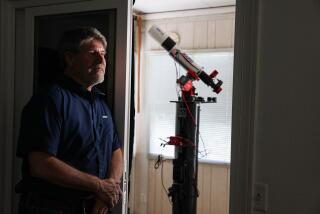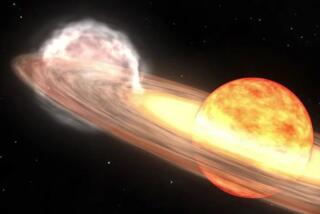This supernova was supposed to die — until it got brighter
- Share via
Talk about going out with a bang — and then another bang. Astronomers at Las Cumbres Observatory have discovered a supernova that has been shining for years instead of mere months, surviving far beyond its expected lifespan.
The strange and still-going stellar explosion, described in the journal Nature, defies scientists’ understanding of dying stars and may force them to rethink their ideas of how stars evolve.
“The supernova offers astronomers their greatest thrill: something they do not understand,” Stan Woosley of UC Santa Cruz, who was not involved in the study, wrote in a commentary.
The supernova known as iPTF14hls didn’t seem like anything out of the ordinary when it was picked up in September 2014 by the Intermediate Palomar Transient Factory telescope near San Diego. The supernova sits some 500 million light-years away in the constellation Ursa Major. Astronomers checked in on it every so often, eventually classifying the bright object as a type II-P supernova that was already beginning to grow dim.
Supernovas are powerful explosions, putting out the brightness of around 100 million suns, but that beacon in the night sky lasts only 100 days or so before fading away. There are a few that might last more than 130 days, but those are very rare. So after a while, astronomers largely ignored iPTF14hls, expecting it would ultimately disappear into the night.
That changed after UC Santa Barbara undergraduate student Zheng Chuen Wong, who was interning at the observatory, was asked to go through old data and see whether anything unusual stuck out. He noticed iPTF14hls still shining some 135 to 140 days since being discovered — and it wasn’t fading. It was getting brighter.
“When he showed it to me, my first reaction was, ‘Well that can’t be a supernova — it must be something else,’” lead author Iair Arcavi, an astrophysicist with UC Santa Barbara and Las Cumbres, a Goleta, Calif.-based global observatory network.
Arcavi figured they’d get a spectrum of the star, splitting its light into a rainbow to read its chemical fingerprint, and they’d figure out what it really was.
“And I was really shocked when it did look like a supernova in the spectrum,” he said. “In fact, it looked like the most common type of supernova. It was the last thing I was expecting to see.”
They kept watching. The supernova ultimately stayed bright for more than 600 days, blowing away the competition. And yet, in spite of its advanced age, it looked like a supernova that was just two months or so old.
It was as jarring as meeting a 600-year-old human — one who looked no older than 60, Arcavi said.
On top of that, iPTF14hls did not follow the normal path for a supernova, Woosley pointed out. It appeared to vary in brightness by as much as 50%, implying that it might be exploding and fading over and over again. It was far more luminous than your typical type II-P supernova, and it had clearly let off far more energy than its peers simply by outlasting them.
“It means there’s definitely another way for stars to explode that doesn’t destroy them completely so they can do it multiple times,” Arcavi said.
What was feeding this mysterious series of explosions? Arcavi and his colleagues narrowed down the possibilities. Perhaps a fast-spinning neutron star, a magnetar, was behind the repeated explosions — but that would mean the supernova should have started out far brighter than this one did. Perhaps the colliding shells of high-speed matter seen in another kind of supernova, known as type IIn, were causing this supernova to shine — but iPTF14hls wasn’t producing the X-rays and radio waves that would be expected if that were happening.
Instead, scientists think this supernova may be a pulsational-pair instability supernova. In this scenario, the inside of a monster star with the mass of 100 suns becomes so hot that some of its energy turns into matter and antimatter. If that happens, the core becomes unstable, triggering an explosion that blows off the star’s outer layers, Arcavi said. If true, iPTF14hls would be the first example of this kind of supernova ever seen.
The researchers looked back in their data from 1954 and found a luminous object right where iPTF14hls sits in the sky. In their data from 1993, that object was gone. It seems iPTF14hls has been slowly flickering for more than half a century.
Even with this theory, not everything lines up, Arcavi said. For example, the star should have blown off all of its hydrogen in its mid-century episode, but the star clearly has plenty of hydrogen left.
“I’ve never seen anything like this,” Arcavi said. “Usually when you see a weird supernova or something for the first time there’s some explanation and then you find more and you work it out. But this one is just defying all of the explanations we have. There’s no model or theory that can fully explain this.”
The original star itself is something of a surprise, he pointed out. Jumbo-sized stars were more common in the universe’s past, when they were made of mostly hydrogen; the more traces of heavy elements in a star’s body, the smaller it tends to be. And those massive stars did not live long – on the order of 100 million years or so, unlike our smaller sun, which has already lived 4.6 billion years.
“That also tells us something about how stars are formed,” Arcavi said. “Also, if these things are common, then whatever kind of elemental abundances they’re ejecting into their galaxy could have a significant effect on the overall abundances of elements that we should be seeing.”
Among the most remarkable things about iPTF14hls is how unremarkable it looks, Arcavi added.
“This is one of the things I love most about this supernova, that its spectrum is so vanilla,” he said.
That means that any explanation for this supernova also has to account for more common supernovas — and the stars that birth.
“A better understanding of iPTF14hls could provide insight into the evolution of the most massive stars, the production of the brightest supernovae and possibly the birth of black holes that have masses near 40 solar masses — such as those associated with the first direct detection of gravitational waves,” Woosley wrote.
It also hints that there may be many other long-lived supernovas that have escaped notice because they’ve been masquerading as more typical stellar explosions. There may be more of them already recorded in the archives, waiting to be found.
The scientist said they’re continuing to observe this supernova to see whether, as time goes by, they’ll be able to peer past the expanding outer layers as they spread and become more transparent, to see the energy source within before it fades completely.
Follow @aminawrite on Twitter for more science news and “like” Los Angeles Times Science & Health on Facebook.
MORE IN SCIENCE
A wake, some prayers and a little retail therapy: How NASA engineers mourn the death of a spacecraft
Scientists prove that the public pays attention to journalism
9-year-old boy with rare disease now has engineered skin covering 80% of his body
UPDATES:
11:35 a.m. Nov. 9: This story was updated with additional information and comment from Stan Woosley of UC Santa Cruz.
This story was originally published Nov. 8 at 6:55 p.m.







